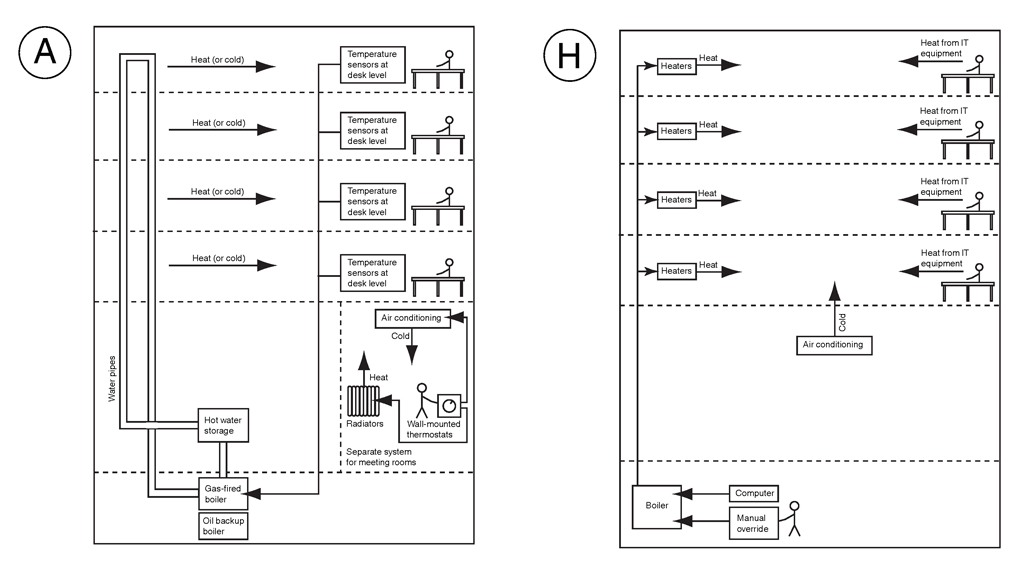
Written for the CarbonCulture blog
Imagine how energy flows…
You might think of something like a bolt of lightning, or visualise a glowing power cable.
The visible glowing of lighting—at home, at work, and in our streets—is indeed a major use of energy, but in the UK, heating is in fact the biggest user (mostly from gas-fired boilers): space heating, water heating, cooking, and so on. And of course we also use energy for cooling—refrigeration, air conditioning, and fans.
Some studies have suggested that we tend to underestimate how much energy heating and cooling uses compared with lighting (perhaps because lighting is so visible), and this potentially affects our understanding of how we could save energy, since we (understandably) focus our efforts on the things that most obviously use it, or that spring to mind most immediately. We may prioritise turning lights off rather than turning the thermostat down a couple of degrees, even though this would save more energy.
Professor David MacKay, DECC’s Chief Scientific Advisor, points out [1] that putting on a jumper when we’re cold and turning home (and work) thermostats down to 15°C or 17°C could save 20 kWh each day, per person—five times as much as changing from incandescent filament to compact fluorescent light bulbs.
That’s not to say that turning lights off and changing to more efficient bulbs is not worth doing, just that our perceptions around energy are not always straightforward. At Sweden’s Interactive Institute, which has developed a reputation for producing clever new ways of representing energy, Magnus Gyllensward, Anton Gustafsson and Magnus Bang devised an electric radiator called Element which uses an array of thirty-five 60W incandescent bulbs to approximate a 2kW heat output [2]. The very visible nature of the energy being used helps raise awareness of the relative quantities used by heating and lighting, and a thermostatic control means that changes in room temperature (caused by, for example, opening a window) are very quickly made evident as the bulbs increase or decrease their glow.
Metering and Displays
For most of us, the main way we have of visualising energy use is both abstract and not very visible: a meter sitting in a cupboard with digits slowly (or quickly) rolling past, only translated into money each month or quarter, or equivalent to credits that we have to get loaded onto a prepay ‘key’.
One of the first steps we can take to making energy more visible might be, of course, taking that meter out of the cupboard and putting it where we can see it more easily (see also the blogpost ‘Design Approaches to Behaviour Change’).
This is doubly true of places of work, where the aggregate of many people’s behaviour and energy use may make it even more difficult to understand our individual contributions.
The next important step in this process—now that we can see the numbers rolling by—is to establish a feedback mechanism so we can tell which actions are causing changes in the speed with which the numbers roll around the meter. The larger the community we’re looking at, the more this is needed, and more innovative approaches are required.
At CarbonCulture, we’ve not only looked at how we can take the meters (and their data) out of cupboards, but how we can ensure these feedback mechanisms exist, so we can be smart about our meters.
We’ve not only shown organisations these feedback mechanisms, but (with their permission) have made their information completely public—you can see the electricity and gas use of a number of UK Government Departments—and we’ve done some thinking about the best ways to display this data:
Are graphs the right answer for everyone, or are there better ways of showing the data? Should we animate what’s going on—perhaps showing power (the rate at which energy is being delivered) rather than energy itself?
Are the actual numbers useful, or would people find it more useful to have a kind of simple signal about what’s going on?
Should we show what individual appliances and devices are using, or what each floor or office or organisational division is doing?
What different ways of visualising the data would be most useful to different groups of people within an organisation?
The ‘units’ of measurement themselves can be a barrier to literacy, but the right unit for the right person can allow understanding in the first place. For different people and different impacts we can use different units. The price of an aeroplane ticket isn’t enough to influence people to choose a less energy intensive form of transport, but maybe the amount of CO2 is. Conversely, the cost of running home or office appliances can often be a bigger influence to purchase more efficient appliances than the carbon footprint will be. In later posts we’ll be exploring what we’re finding out about some of these questions, how they relate to energy literacy, and what we see as a way forward for the field. We’ll also be looking at people’s mental models of energy and behaviour, and how these are linked.
[1] David MacKay (2008), Sustainable Energy—Without the Hot Air, p.229. UIT Publishing, Cambridge. Available at http://www.withouthotair.com
[2] Magnus Gyllensward, Anton Gustafsson and Magnus Bang (2006), ‘Visualising energy consumption of radiators’. Proceedings of Persuasive 2006: First International Conference on Persuasive Technology, pp.167-170.